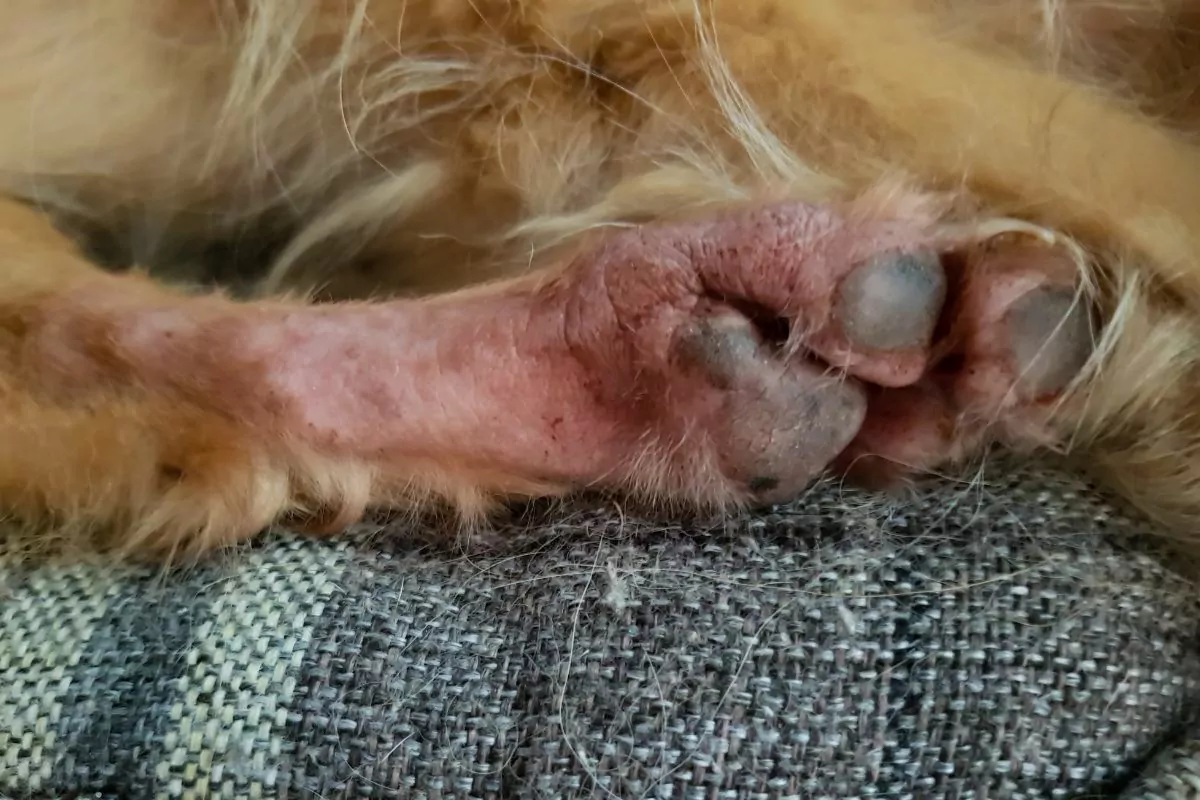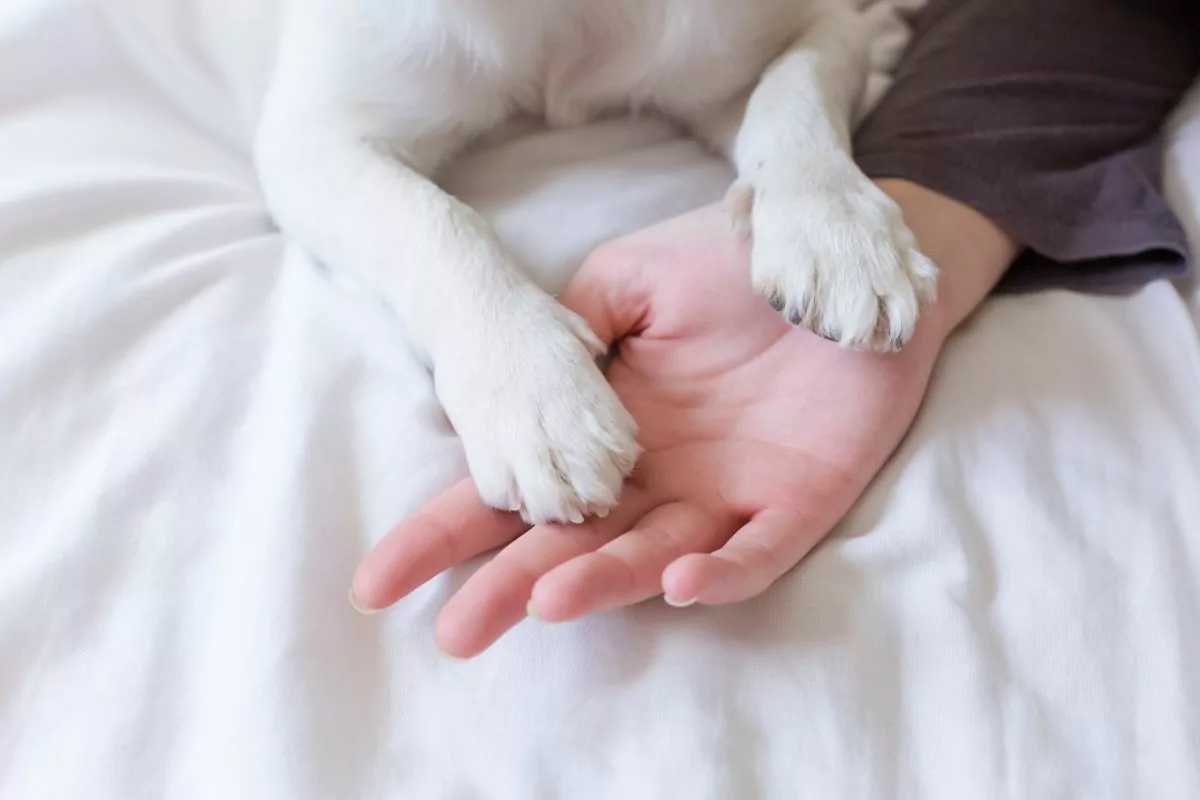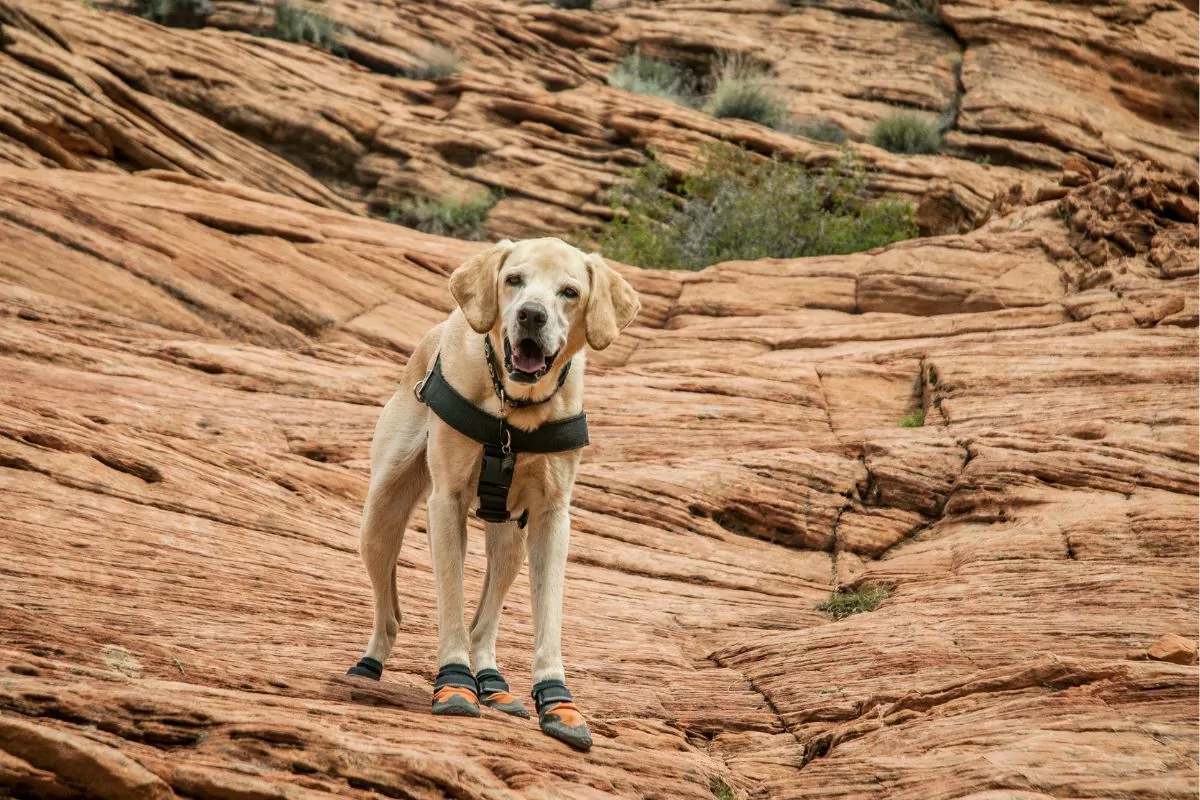Can Dogs Get Blisters On Their Paws?
Blisters on dog paws are a condition that tugs at the heartstrings of any pet owner. Picture your furry companion, usually full of energy and joy, now limping in discomfort.
These blisters, often caused by overexertion on rough surfaces or extreme temperatures, manifest as painful, swollen areas on their delicate paw pads.
This heart-rending sight reminds us of our duty to protect these loyal friends from harm and discomfort.

How Did My Dog Get a Blister on Their Paw?
Your beloved dog’s paw blister is a poignant reminder of their vulnerability. It could stem from an innocent adventure turned awry, perhaps a spirited run on rough terrain or a prolonged walk on scorching pavement, unbeknownst to you, harming their tender pads.
Alternatively, it might result from contact with harsh chemicals or allergens, which attack their sensitive skin like an invisible enemy. Each step they now take might be a tiny battle against discomfort.
This situation deeply resonates with any empathetic pet owner’s heart, urging immediate care and attention to soothe their loyal companion’s pain.
Signs of Blisters on Canine Paws
Witnessing signs of blisters on my dog’s paws is an emotional experience filled with concern and empathy. These signs often manifest as visible swellings or bumps on the paw pads, a sight that can tug at your heartstrings.
Your dog might exhibit a noticeable limp, each step a testament to their discomfort. They may frequently lick or chew at their paws, a silent plea for relief from the irritation. You might also observe a change in their walking pattern, an unusual hesitance reflecting their pain. Each of these signs calls for your nurturing attention, a reminder of the deep bond you share.
Types of Blisters Found on Dog Paws
In the world of canine care, understanding the types of blisters found on dog paws is crucial.
These blisters, medically known as vesicles or bullae, depending on their size, are more than just physical ailments; they are silent cries for help, each type echoing a different underlying issue.
Friction Blisters on Dog’s Paws
These are common and often result from repeated rubbing against rough surfaces. Imagine your dog, full of life and energy, unknowingly harming its delicate paw pads during play or long walks. In this case, the epidermis separates from the dermis, causing fluid-filled spaces and pain and discomfort.
Burn Blisters on Dog’s Paws
Exposure to extreme temperatures or harmful chemicals causes these conditions. The thermal or chemical burn damages the skin layers, leading to fluid accumulation and painful, reddened areas on the paws.
Blood Blisters on Dog’s Paws (Hemorrhagic Blisters)
Trauma or injury often causes these conditions. Disrupting blood vessels under the skin results in blood-filled blisters, indicating your dog’s pain.
Allergic Blisters on Dog’s Paws
Allergens trigger these blisters and symbolize your dog’s unseen battle against irritants. They arise from an inflammatory response, causing swelling and discomfort in the paw pads.
Each blister type represents a unique challenge in your dog’s life, a problem that demands your compassionate attention and care. Recognizing and understanding these blisters is a step towards alleviating your furry friend’s distress, a journey filled with emotional and medical undertakings.

Causes of Canine Blisters
The causes of canine blisters, medically known as vesicular formations, are diverse and profoundly concerning for any empathetic pet owner. One primary cause is frictional trauma, where repeated rubbing against harsh surfaces disrupts the stratum corneum’s integrity, the epidermis’s outermost layer, leading to fluid accumulation under the skin.
This is heartbreakingly common in active dogs who may unknowingly injure themselves in their enthusiasm.
Another cause is thermal injury. Picture your dog innocently stepping onto scalding pavement or ice, where extreme temperatures damage the delicate basal keratinocytes, cells in the deepest layer of the epidermis, resulting in painful blisters.
Contact dermatitis, an inflammatory reaction to irritants or allergens, can also lead to vesicular formations. The allergens trigger an immune response, causing fluid to build up under the skin and creating blisters.
Each of these causes represents potential pain and discomfort for your loyal companion.
How to Treat Blisters on Dog’s Paws
Treating blisters on a dog’s paws requires a multifaceted approach, and addressing their pain becomes a priority.
- Initial Assessment and Cleaning: Clean the affected area with a mild antiseptic solution. This reduces the risk of secondary bacterial infections, a concern in a blister’s warm, moist environment or vesicle.
- Application of a Protective Barrier: Use a pet-safe antibacterial ointment to create a barrier, promoting healing in the damaged stratum corneum and underlying epidermal layers. This step is crucial in providing relief and protection.
- Bandaging and Paw Protection: Soft, breathable bandages can be applied to prevent further irritation and injury. This physical barrier also reduces the risk of the dog aggravating the blister through licking or biting, behaviors often driven by their discomfort.
- Pain Management: Administer veterinarian-prescribed analgesics or anti-inflammatory medications if necessary. This helps manage pain and inflammation at the cellular level, ensuring your dog’s comfort.
- Environmental and Activity Modifications: Limiting your dog’s exposure to harsh surfaces and moderating their activity level can prevent the worsening of the existing blisters and the formation of new ones.
- Regular Monitoring and Veterinary Consultation: Regularly inspect the paws for signs of healing or any worsening condition. Consult a veterinarian if the blisters do not improve or if there are signs of infection, such as increased redness, swelling, or pus.
Each step in this treatment protocol is imbued with scientific understanding and a deep sense of empathy, reflecting the bond between you and your dog.
When to Call the Vet
It’s crucial to call the vet if these blisters worsen or show signs of infection like increased redness, swelling, or pus. If your dog seems in pain, limping, or excessively licking its paws, it signals it needs professional care.
Trust your instincts; your bond with your pet will guide you in recognizing when to seek a veterinarian’s compassionate expertise.
How to Keep Your Dog’s Paws Blister-Free
To keep your beloved dog’s paws blister-free:
- Envelop them in care and vigilance.
- Start by choosing softer, cooler paths for walks, avoiding rough asphalt or hot surfaces that can harm their tender pads.
- Regularly moisturize their paws with a pet-safe balm, nurturing the skin and preventing cracks.
Trim their nails and the fur between pads to prevent uncomfortable matting and pressure. After outdoor adventures, gently wash their paws to remove irritants. Invest in protective booties for extreme conditions, a small step towards safeguarding their joyful romps.
Each action is a token of your love, ensuring their paws remain healthy and their spirits high.
FAQs
Regarding blisters on dog’s paws, pet owners often have a sea of questions, each reflecting deep concern and love for their furry companions.
What causes blisters on my dog’s paws?
The primary culprits include:
- Excessive walking on rough surfaces.
- Causing friction blisters.
- Exposure to extreme temperatures leads to thermal injury.
- Contact with irritants results in allergic reactions.
Each cause is a potential source of pain for your dog, making prevention and care crucial.
Can I Treat My Dog’s Blister at Home?
Minor dog paw blisters can be treated with gentle cleaning and a pet-safe antibacterial ointment. However, it’s essential to monitor the blister for any signs of infection and consult a veterinarian if there’s no improvement.
When Should I Take My Dog to the Vet for a Blister?
Seek veterinary attention if the dog paw blister appears infected (oozing pus, excessive redness, swelling) or if your dog is in significant pain. A professional examination ensures proper treatment and peace of mind.
How Can I Prevent Blisters on My Dog’s Paws?
Prevent blisters by choosing softer terrains for walks, using protective paw balm, and considering booties for harsh conditions. Regular paw checks and grooming also play a crucial role in prevention.

Are Some Dog Breeds More Prone to Blisters?
Yes, active dog breeds and those with sensitive skin may be more susceptible to blisters. Some of the most popular active dog breeds are Golden Retrievers, German Shepherds, Jack Russel terriers, Border collies, Australian Shepherds, Dobermans, and Huskies.
However, any dog can develop blisters under the right conditions, making universal precautions necessary.
Each question and its answer deepen your understanding and ability to care for your dog, weaving a tapestry of nurturing and love that helps keep their paws healthy and their tails wagging.
Final Words
In caring for our beloved dogs, understanding and addressing issues like blisters on their paws is a testament to our love and commitment. It’s a journey of emotional and practical care, where our actions can profoundly impact their quality of life.
Always consult a veterinarian for tailored advice, ensuring your precious companion remains healthy, happy, active, and dog paw blister-free.
